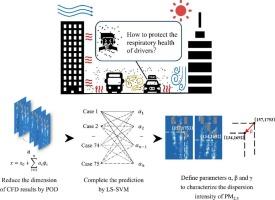A data-driven investigation on PM2.5 dispersion and the relevant professional driver exposure risks induced by compound turbulence in street canyons
IF 6.9
2区 工程技术
Q1 ENVIRONMENTAL SCIENCES
引用次数: 0
Abstract
Traditional experimental methods for collecting and analyzing particulate matter (PM) concentration distribution data within street canyons face significant limitations, including the passivity of experimental conditions, coarse spatial resolution, and excessive time requirements. To overcome these issues, the data-driven approach that enables rapid flow field prediction based on finite simulation data from computational fluid dynamics has been developed. Firstly, PM2.5 dispersion flow fields were simulated for 75 scenarios in a typical street canyon, Qingnian Road, Wuhan, China. Proper Orthogonal Decomposition (POD) was then applied to extract mode coefficients from these data, followed by Least Square Support Vector Machine (LSSVM) used to establish mappings between mode coefficients and operating parameters, enabling rapid flow field prediction. The movement of the centroid of the PM2.5 concentration field β was defined to assess the spatial variation of PM2.5, while a normalized parameter γ was employed to evaluate the dispersion intensity of PM2.5. Concurrently, an exposure risk assessment model was introduced to evaluate the traffic-related PM2.5 exposure risks for professional drivers who are chronically exposed within their working environments. The results indicated that vehicle-induced turbulence is the primary factor affecting dispersion of PM2.5, and there is a critical vehicle speed at which the dispersion intensity increases sharply once exceeded, which provides actionable guidance for drivers to adjust driving habits and optimize ventilation strategies to reduce long-term exposure to high PM2.5 exposure risk.

街道峡谷复合湍流对PM2.5扩散及相关职业驾驶员暴露风险的数据驱动调查
传统的街道峡谷内颗粒物(PM)浓度分布数据采集与分析实验方法存在实验条件被动、空间分辨率不高、时间要求等诸多局限性。为了克服这些问题,数据驱动的方法可以基于计算流体动力学的有限模拟数据进行快速流场预测。首先,对武汉市青年路典型街道峡谷75种场景下的PM2.5弥散流场进行模拟。然后利用适当的正交分解(POD)从这些数据中提取模态系数,然后利用最小二乘支持向量机(LSSVM)建立模态系数与运行参数之间的映射关系,实现快速流场预测。定义PM2.5浓度场质心的运动β来评价PM2.5的空间变化,采用归一化参数γ来评价PM2.5的弥散强度。同时,引入暴露风险评估模型,对职业驾驶员在工作环境中长期暴露的交通相关PM2.5暴露风险进行评估。结果表明,车辆湍流是影响PM2.5扩散的主要因素,且存在一个临界车速,一旦超过该车速,扩散强度就会急剧增加,这为驾驶员调整驾驶习惯、优化通风策略以降低长期暴露于高PM2.5暴露风险提供了可操作性指导。
本文章由计算机程序翻译,如有差异,请以英文原文为准。
求助全文
约1分钟内获得全文
求助全文
来源期刊

Urban Climate
Social Sciences-Urban Studies
CiteScore
9.70
自引率
9.40%
发文量
286
期刊介绍:
Urban Climate serves the scientific and decision making communities with the publication of research on theory, science and applications relevant to understanding urban climatic conditions and change in relation to their geography and to demographic, socioeconomic, institutional, technological and environmental dynamics and global change. Targeted towards both disciplinary and interdisciplinary audiences, this journal publishes original research papers, comprehensive review articles, book reviews, and short communications on topics including, but not limited to, the following:
Urban meteorology and climate[...]
Urban environmental pollution[...]
Adaptation to global change[...]
Urban economic and social issues[...]
Research Approaches[...]
 求助内容:
求助内容: 应助结果提醒方式:
应助结果提醒方式:


